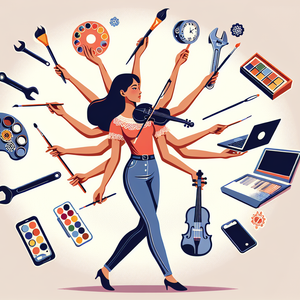Portfolio Careers and the Creative Renaissance: How Multi-Hyphenate Lives are Redefining Artistic Success

A portfolio career goes beyond simple freelancing or gig work. It is a conscious, strategic approach to career-building, where diverse streams of income and interests are woven together into a singular professional tapestry. For those in the arts—writers, designers, musicians, and more—this model offers the flexibility to pursue multiple passions while adapting to evolving market demands. This shift has been fueled by both necessity and aspiration. Traditional full-time roles in the arts are increasingly scarce, competitive, and often underpaid. According to a 2023 LinkedIn survey, over 60% of creative professionals under 40 report holding more than one active role at any given time. These range from freelance illustration and music production to teaching, consulting, and running online shops. The move toward portfolio careers is not just about making ends meet; it is a quest for autonomy, diversity, and a more authentic form of self-expression.
Blending Commercial and Passion Projects
One of the most defining features of the portfolio career is the ability to balance commercial work with passion projects. This dual approach allows creatives to support themselves financially while also carving out time and resources to explore personal interests or experimental work. For example, a graphic designer might spend mornings creating branding materials for clients, and afternoons working on a self-published zine or art prints. Similarly, a novelist may supplement their income by ghostwriting, editing, or teaching creative writing workshops. This blend is mutually beneficial: commercial gigs provide exposure to new ideas, tools, and collaborators, while personal projects foster innovation and keep creative energies alive. Such a model ensures not only sustainability but also continued growth. The cross-pollination between commercial and personal work can lead to unexpected breakthroughs, fresh styles, and a more resilient creative identity.
Case Study: The Multi-Hyphenate Artist
Consider the experience of Emma Lacey, a London-based photographer and illustrator. Like many artists, Lacey initially depended on gallery exhibitions, but soon realized that this alone wasn’t enough for financial security. By diversifying her professional activities—offering online illustration courses, licensing her photographs, and consulting for advertising agencies—Lacey stabilized her income while expanding her creative reach. According to her, “Each part of my portfolio feeds into the other. Teaching inspires my work, and my commercial projects fund the art I want to make.” Lacey’s story is emblematic of a broader shift: artists no longer need to choose between financial security and creative risk-taking. Instead, they can design careers that are as multifaceted and dynamic as their imaginations.
Platforms and Communities Fueling the Renaissance
The digital revolution has been a key catalyst in this Creative Renaissance. Platforms like Behance, Patreon, and Substack provide channels for artists to showcase their work, build communities, and earn income directly from fans and clients. Marketplaces such as Etsy and Society6 allow creatives to sell products globally, bypassing traditional gatekeepers and reaching a wider audience. Online networks also facilitate collaboration and skill-sharing. Musicians partner with filmmakers on TikTok, illustrators design merchandise for YouTubers, and writers launch podcasts to engage with new communities. The result is a flattening of the creative hierarchy, democratizing who gets to participate and succeed. In essence, technology is making it easier than ever for creatives to assemble their own “portfolio” of projects and income streams, while also connecting with collaborators and supporters around the world.
Overcoming Challenges: Balance and Burnout
Despite its many advantages, the portfolio career model is not without challenges. Managing multiple projects, clients, and deadlines can be overwhelming, and the risk of burnout is real. Creatives must become adept not just at their craft, but also at project management, marketing, and self-care. Many address these challenges by joining co-working spaces, online accountability groups, or using productivity tools to structure their time. The evolving conversation around success also helps: rather than being defined by a single job title or employer, success is increasingly measured by impact, satisfaction, and the freedom to pursue what matters most.
Portfolio careers represent more than just a passing trend; they are a powerful movement reshaping the very definition of artistic success. By blending commercial work with passion projects, creatives are achieving both financial security and unprecedented freedom for experimentation. As technology continues to connect creative minds and break down traditional barriers, the possibilities for portfolio careers—and the Creative Renaissance they foster—are virtually limitless. In this new era, being a “multi-hyphenate” is not a mark of indecision, but a testament to adaptability, innovation, and self-determination. The creative world is more vibrant and accessible than ever, and portfolio careers are leading the charge. For creatives everywhere, the Renaissance is now.
Creative Content Strategist (for Multi-Platform Brands)
Ogilvy, R/GA, startups, media companies, large brands
Core Responsibilities
Develops and executes integrated content strategies across digital, social media, print, and experiential channels, aligning with brand voice and audience growth goals.
Collaborates with freelance writers, designers, and videographers to produce cohesive campaign narratives and branded storytelling.
Required Skills
Expertise in analytics tools (such as Google Analytics, Sprout Social)
Trend forecasting
SEO best practices
Unique Aspects
Works across multiple platforms and channels
Focus on brand voice and audience growth
Online Course Creator (Arts & Creative Skills)
Self-employed, e-learning platforms (Skillshare, Teachable), universities, creative studios
Core Responsibilities
Designs, produces, and markets educational video courses or interactive workshops in fields such as illustration, photography, or music.
Manages all aspects of curriculum development, from scripting and filming content to editing and online platform management.
Required Skills
Strong teaching/presentation skills
Subject-matter expertise
Familiarity with e-learning technologies and marketing strategies
Unique Aspects
Frequently self-employed or contracted by e-learning platforms
Licensing & Merchandising Consultant (Visual Arts & Design)
Art + Commerce, Creative Artists Agency, independent art collectives, self-employed
Core Responsibilities
Advises artists and designers on monetizing their work through product licensing, collaborations, and brand partnerships.
Negotiates contracts, manages intellectual property rights, and identifies market opportunities for expansion into new product categories.
Required Skills
In-depth knowledge of copyright law
Negotiation tactics
Trends in retail and e-commerce
Unique Aspects
Focus on monetization through licensing and partnerships
Community Manager for Creative Platforms
Tech startups, online marketplaces, creative membership platforms
Core Responsibilities
Cultivates and moderates online communities for creative professionals on platforms like Behance, Patreon, or Discord.
Organizes virtual events, workshops, and networking sessions to support member growth and learning.
Required Skills
Excellent communication skills
Conflict resolution abilities
Deep understanding of the needs and challenges of creative freelancers
Unique Aspects
Fosters engagement and collaboration in creative communities
Hybrid Artist-Educator (Museum/Community Outreach)
Tate, local arts councils, arts non-profits, independent contractors
Core Responsibilities
Designs and delivers participatory workshops, artist talks, and public engagement programs in museums, galleries, or arts non-profits.
Balances personal studio practice with educational and outreach responsibilities, often developing interdisciplinary or community-based projects.
Required Skills
Strong exhibition record
Ability to adapt artistic process for diverse audiences
Experience in curriculum or program design
Unique Aspects
Works in both education and personal artistic practice


